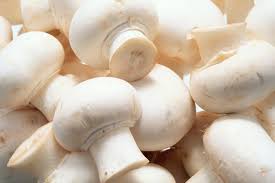What is Mushroom ?


A mushroom is the fleshy, spore-bearing fruiting body of a fungus, typically produced above ground on soil or on its food source.
Mushrooms are of two types :- 1. Ediable and 2. Non Edible
Edible mushrooms include many fungal species that are either harvested wild or cultivated. Edible mushrooms are consumed by humans as comestibles for their nutritional value and they are occasionally consumed for their supposed medicinal value.
Before assuming that any wild mushroom is edible, it should be identified. Accurate determination and proper identification of a species is the only safe way to ensure edibility, and the only safeguard against possible accident. Some mushrooms that are edible for most people can cause allergic reactions in some individuals, and old or improperly stored specimens can cause food poisoning. Great care should therefore be taken when eating any fungus for the first time, and only small quantities should be consumed in case of individual allergies. Deadly poisonous mushrooms that are frequently confused with edible mushrooms and responsible for many fatal poisonings include several species of the Amanita genus, in particular, Amanita phalloides, the death cap. It is therefore better to eat only a few, easily recognizable, species, than to experiment indiscriminately.
NUTRITION
Mushrooms are a low-calorie food eaten cooked, raw or as a garnish to a meal. In a 100 g (3.5 ounce) serving, mushrooms are an excellent source (higher than 20% of the daily value, DV) of B vitamins, such as riboflavin, niacin and pantothenic acid, an excellent source of the essential minerals, selenium (37% DV) and copper (25% DV), and a good source (10-19% DV) of phosphorus and potassium.
Fat, carbohydrate and calorie content are low, with absence of vitamin C and sodium. There are 27 calories in a typical serving of fresh mushrooms (table) .
Many mushroom species produce secondary metabolites that can be toxic, mind-altering, antibiotic, antiviral, or bioluminescent. Although there are only a small number of deadly species,
several others can cause particularly severe and unpleasant symptoms.
Toxicity likely plays a role in protecting the function of the
basidiocarp: the mycelium has expended considerable energy and
protoplasmic material to develop a structure to efficiently distribute
its spores. One defense against consumption and premature destruction is
the evolution of chemicals that render the mushroom inedible, either
causing the consumer to vomit the meal (see emetics), or to learn to avoid consumption altogether. In addition, due to the propensity of mushrooms to absorb heavy metals, including those that are radioactive, European mushrooms may, to date, include toxicity from the 1986 Chernobyl disaster and continue to be studied.

A mushroom is the fleshy, spore-bearing fruiting body of a fungus, typically produced above ground on soil or on its food source.
Mushrooms are of two types :- 1. Ediable and 2. Non Edible
Edible mushrooms include many fungal species that are either harvested wild or cultivated. Edible mushrooms are consumed by humans as comestibles for their nutritional value and they are occasionally consumed for their supposed medicinal value.
Before assuming that any wild mushroom is edible, it should be identified. Accurate determination and proper identification of a species is the only safe way to ensure edibility, and the only safeguard against possible accident. Some mushrooms that are edible for most people can cause allergic reactions in some individuals, and old or improperly stored specimens can cause food poisoning. Great care should therefore be taken when eating any fungus for the first time, and only small quantities should be consumed in case of individual allergies. Deadly poisonous mushrooms that are frequently confused with edible mushrooms and responsible for many fatal poisonings include several species of the Amanita genus, in particular, Amanita phalloides, the death cap. It is therefore better to eat only a few, easily recognizable, species, than to experiment indiscriminately.
NUTRITION
Mushrooms are a low-calorie food eaten cooked, raw or as a garnish to a meal. In a 100 g (3.5 ounce) serving, mushrooms are an excellent source (higher than 20% of the daily value, DV) of B vitamins, such as riboflavin, niacin and pantothenic acid, an excellent source of the essential minerals, selenium (37% DV) and copper (25% DV), and a good source (10-19% DV) of phosphorus and potassium.
Fat, carbohydrate and calorie content are low, with absence of vitamin C and sodium. There are 27 calories in a typical serving of fresh mushrooms (table) .

